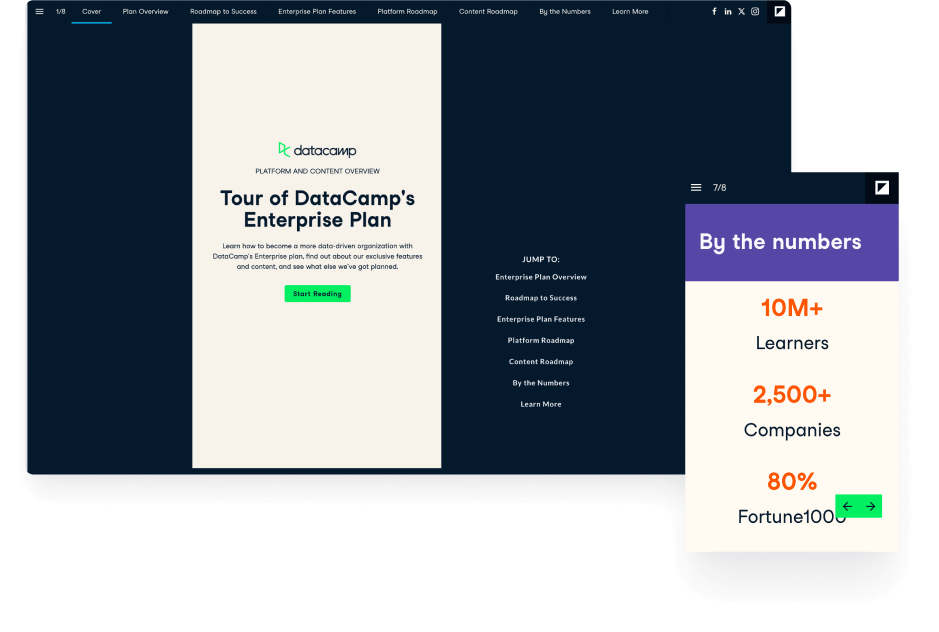To succeed as a sales professional in 2025, you’ve got to be able to respond to changes in a heartbeat. Not only are you working with buyers and stakeholders who can throw a left-field question at you at any time — but you’re dealing with constant shifts in the market, as well as prospects with increasingly complex decision-making cycles. Being nimble is the name of the game.
So, how do salespeople stay prepared in a world that’s constantly changing? Sales readiness is the answer. This blog will break down the definition of sales readiness and why it’s important, as well as provide a few best practices for measuring sales readiness.
What is sales readiness?
Sales readiness is the practice of giving your sales team the confidence, tools, and knowledge to effectively engage prospects, address their needs, and close deals. Investing in sales readiness means that your sales reps should be able to handle every stage of the b2b buyer journey confidently — no matter what gets thrown at them.
Why is sales readiness important?
Of course, it never hurts to stay prepared. But sales readiness is especially important in 2025 for several reasons:
Buyers are more informed than ever
It’s 2025, and your buyers now have access to countless online resources for doing their research, before they even interact with your sales team. According to HubSpot’s State of Sales report, a whopping 96% of prospects research companies and products before engaging with a sales rep.
This means they’re entering conversations armed with knowledge about products, competitors, pricing — the lot. So, your sales reps always need to be two steps ahead. Sales readiness ensures your team can share tailored insights that go deeper than the information prospects can find on their own.
Sales cycles are more complex than ever
Not only are your sales reps working with super-prepared buyers — they’re also contending with increasingly complex sales cycles and intricate buyer committees.
But the good news is that, despite all these changes, buyers still value a great experience with sales. In fact, 89% of consumers say that they buy based on overall sales experience over price and functionality. In other words: Sales interactions are your time to shine — so you'd better be prepared. Sales readiness gives your reps the tools and knowledge to anticipate objections from throughout the buyer group and address the needs of multiple stakeholders.
It’s harder than ever to stand out
The marketplace in 2025 is more crowded, meaning that your sales team has an important part to play when it comes to differentiating your brand.
Sales readiness equips sales reps to tell a compelling and unique story about your b2b brand, leaving them confident that you’ll offer value your competitors will struggle to match.
Sales readiness vs sales enablement
Sales enablement and sales readiness are both crucial for your sales team’s success. But the two are not interchangeable.
While sales enablement focuses on equipping reps with the right tools and content to understand your product, brand, and customer, sales readiness prepares reps to apply what they’ve learned in the real world. Put simply, sales enablement is about the "what," and sales readiness is all about the “how.
Different types of sales readiness
If you’re aiming to improve sales readiness in your organization, there are a few key areas to focus on:
Communication skills
To make sure they’re ready to present your brand and products in the best light, salespeople need to have stellar communication skills, so that they can tell a compelling story, handle objections, and negotiate with prospects where needed.
Product knowledge
Sales reps need to have a strong understanding of your product, key benefits, and features, as well as how your brand differs from competitors. For this, they need to have deep knowledge of specific features and the problems they solve, as well as how your product measures up against the competition.
Your sales team should also be able to reference a number of relevant use cases or customer stories to add some much-needed social proof to their conversations.
Market knowledge
In addition to knowing all the ins and outs of your products and services, your sales team needs to have an understanding of the broader market landscape.
This includes any current industry trends that might affect the purchase, your competitors, and how they’re positioned in the market, as well as any economic factors that might come into play.
Mindset
Handling unexpected objections from prospects requires a positive mindset and a can-do attitude. To apply their knowledge and skills out in the wild, sales reps need to be able to find solutions on the fly and stay resilient, even in the face of rejection.
By combining product and market knowledge with communication techniques and a growth mindset, sales readiness gives sales reps a rock-solid foundation for navigating the ever-shifting buyer landscape.
Sales readiness best practices
Preparing your team for the complex world of sales will look different depending on factors like your industry, your team construction, and more.
But there are a few good rules of thumb to apply when you’re aiming for sales readiness:
Implement training and encourage upskilling
Provide your sales team with regular training to keep them up to speed with developments in the competitive environment and market. And if you feel they're lagging behind in a specific area, such as mindset or product knowledge, why not set up an internal workshop to help them hone their skills?
Make sales enablement content easily accessible
Sales enablement and sales readiness go hand-in-hand. So make sure that your sales reps have easy access to all the content and sales collateral that they need to have informed, accurate conversations with your buyers.
Practice, practice, practice
Your sales team can know your buyers, your product, and the market like the back of their hands. But applying that knowledge in real life with actual prospects? That's another ball game entirely.
Create opportunities for your sales team to apply what they’ve learned to different scenarios in a low-pressure setting, like a mock presentation or an objection-handling role play. This will give them the confidence to think on their feet when it comes to interacting with real customers.
Encourage continuous learning
Sales readiness is an ongoing process, not a one-time thing. Give sales reps the opportunity to share lessons learned and give each other feedback. And of course, celebrate their successes, when things go right!
How to measure sales readiness
If you’ve invested a lot of time and resources into ensuring sales readiness, you’ll want to know whether your efforts are making a difference. There are a few key areas to focus on when it comes to sales readiness metrics:
Content engagement metrics
Sales readiness relies on equipping salespeople with the knowledge and skills they need to demonstrate your product’s value at every stage of the buyer journey.
Hosting training materials like sales presentations, case studies, or white papers on web-based publications allows you to determine whether your sales reps have engaged with and properly understood your sales enablement materials.
Interactive elements such as quizzes and polls can also give you an idea of which areas reps excel in and which may need to be addressed with additional training.
Tip: Creating internal sales enablement content with built-in analytics allows you to see which content your reps are engaging with.
Efficiency metrics
It sounds obvious but, the better prepared your sales reps are, the more productive they’ll be. Looking at the average time it takes a newly-onboarded sales rep to ramp up to full capacity from their first day by tracking progress through digital handbooks can be a helpful indicator of whether your sales readiness initiatives are effective for new starters.
For the sales reps who are already out of their ramp-up period, pay attention to metrics like their quota attainment and win rate, to get an idea of how they’re performing. To calculate a rep’s win rate, you can divide the number of closed-won deals by their total number of deals.
Growth metrics
If your sales readiness initiatives are working, then you should ultimately see this reflected in your pipeline. Looking at metrics like your average sales cycle length and your sales conversion rate will help you get an idea of how well-prepared your sales reps are.
To calculate your sales conversion rate, you need to divide the number of leads that are turned into sales by the number of leads that your sales team receives in the pipeline. A strong sales conversion rate is a good indicator that your sales reps are well-informed and prepared to sell your product.
Final thoughts
The reality is that the world of sales — especially B2B sales — has altered drastically in the last five to ten years. Prospects are more informed than ever, buyers journeys are increasingly complicated, and the marketplace is hyper-competitive. All of this makes closing deals that little bit harder for your sales reps.
But, by investing in regular training and creating opportunities to put learning into practice, you’ll prepare your sales team to handle any curveball with ease. Combine this with sales enablement and a culture of continuous improvement, and you’ll have a team ready to wow prospects and close deals even faster.
Looking for more ways to set up your sales team for success? Check out our ultimate guide to sales enablement.



